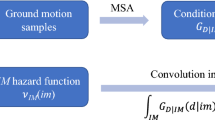Abstract
A finite element-based reliability analysis approach is proposed to estimate the risk of structures under short duration dynamic loadings including seismic loading in the time domain. The proposed approach is parallel to the deterministic finite element method, except that it can incorporate the information on the uncertainty in the essential variables present in the problem under consideration. In the algorithm, the incorporation of uncertainties of all the seismic loading and resistance-related parameters is successfully accomplished by using the concepts of response surface method, the first-order reliability method, and an iterative linear interpolation scheme. Therefore, the rational integration of these methods with a finite element formulation leads to the stochastic finite element-based algorithm. It is capable of capable of capturing any special features that can be handled by the finite element method, making it a robust reliability assessment technique. One of its distinguishing features is that actual earthquake loading time histories can be used to excite structures so that the realistic loading conditions can be simulated. Furthermore, it has the potential to estimate the risk associated with both the serviceability and the strength limit states. The algorithm has been extensively verified using the Monte Carlo simulation technique. Although two examples are given for the steel frame building structure in this paper, applicability of the proposed approach can be easily extended to other types of structures.
Similar content being viewed by others
References
American Institute of Steel Construction (1994)Manual of Steel Construction: Load and Resistance Factor Design. AISC, Chicago, Illinois.
Bucher, C.G. and Bourgund, U. (1990). “A fast and efficient response surface approach for structural reliability problems.”Structural Safety, Vol. 7, pp. 57–66.
Bucher, C. G., Chen, Y. M., and Schüller, G. I. (1989). “Time variant reliability analysis utilizing response surface approach,”Reliability and Optimization of Structural Systems ’88: Proc., 2 nd IFIP WG7.5 Conf., Springer-Verlag, Berlin, Germany, pp. 1–14.
Haldar, A. and Mahadevan, S. (2000).Probability, Reliability and Statistical Methods in Engineering Design. John Wiley & Sons, New York, N.Y.
Haldar, A. and Nee, K. M. (1989). “Elasto-Plastic Large Deformation Analysis of PR Steel Frames for LRFD.”Computers and Structures, Vol. 31, No. 5, pp. 811–823.
Huh, J. (1999).Dynamic Reliability Analysis for Nonlinear Structures Using Stochastic Finite Element Method, PhD dissertation, The University of Arizona, Tucson, Arizona, U.S.A.
Huh, J. and Haldar, A. (1999). “Reliability Analysis of Nonlinear Frames under Seismic Loadings.”13th ASCE Engineering Mechanics Division Conference (CD-ROM proceeding), Baltimore, Maryland.
Khuri, A. I. and Cornell, J. A. (1996).Response Surfaces Designs and Analyses. Marcel Dekker, New York, N.Y.
Kondon, K. and Atluri, S. N. (1987). “Large-deformation, elasto-plastic analysis of frames under nonconservative loading, using explicity derived tangent stiffnesses based on assumed stresses.”Computational Mechanics, Vol. 2, No. 1, pp. 1–25.
Kim, S. H. and Na, S. W. (1997). “Response surface method using vector projected sampling points.”Structural Safety, Vol. 19, No. 1, pp. 3–19.
Leger, P. and Dussaults, S. (1992). “Seismic-energy dissipation in MDOF structures.”Journal of Structural Engineering, ASCE, Vol. 118, No. 5, pp. 1251–1269.
Lucas, J. M. (1974). Optimum Composite Designs.Technometrics, Vol. 16, No. 4, pp. 561–567.
Rajashekhar, M. R. and Ellingwood, B. R. (1993). “A new look at the response surface approach for reliability analysis.”Structural Safety, Vol. 12, pp. 205–220.
Uang, C. M., Yu, Q. S., Sadre, A., Bonowitz, D., and Youssef, N. (1995). “Performance of a 13-Story Steel Moment-Resisting Frame damaged in the 1994 Northridge Earthquake, Technical Report SAC 95-04, SAC Joint Venture.
Author information
Authors and Affiliations
Corresponding author
Additional information
The manuscript for this paper was submitted for review on October 11, 2000.
Rights and permissions
About this article
Cite this article
Huh, J. SFEM-based seismic risk analysis of nonlinear structures using sequential RSM. KSCE J Civ Eng 4, 201–211 (2000). https://doi.org/10.1007/BF02823967
Issue Date:
DOI: https://doi.org/10.1007/BF02823967




